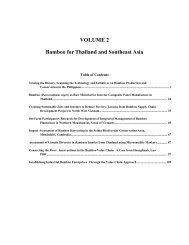WBC-VIII-Vol.4 – Resources – Forestry, Plantations and ... - BambuSC
WBC-VIII-Vol.4 – Resources – Forestry, Plantations and ... - BambuSC
WBC-VIII-Vol.4 – Resources – Forestry, Plantations and ... - BambuSC
You also want an ePaper? Increase the reach of your titles
YUMPU automatically turns print PDFs into web optimized ePapers that Google loves.
Table 24: Species per Site - Benchmark Analysis <strong>and</strong> Relative Yield Performance<br />
Ranking of Species per Site Based on Combined Benchmark Comparison <strong>and</strong> Site Performance Data<br />
Rank Site Species<br />
Benchmark Comparison Data<br />
H D WT DM<br />
Site Performance Data<br />
AC EY RYS<br />
1 Gede B. vulgaris 53% 86% 80% 37% 30 13.0 81%<br />
2 " " T. siamensis 67% 63% 63% 26% 39 5.4 80%<br />
3 " " D. br<strong>and</strong>isii 60% 83% 100% 49% 6 17.8 47%<br />
4 " " D. strictus 90% 38% 38% 13% 25 7.5 78%<br />
5 " " D. hamiltonii 45% 50% 50% 11% 30 11.3 39%<br />
6 " " D. membranaceus 50% 50% 50% 12% 28 7.2 20%<br />
7 " " B. bambos 45% 42% 42% 8% 25 9.4 23%<br />
1 Jilore D. membranaceus 67% 70% 100% 46% 39 36.8 100%<br />
2 " " B. bambos 75% 75% 75% 38% 22 40.2 100%<br />
3 " " D. hamiltonii 50% 60% 60% 18% 28 16.9 58%<br />
1 Kakamega B. vulgaris 53% 100% 90% 48% 28 16.0 100%<br />
2 " " D. br<strong>and</strong>isii 48% 92% 83% 37% 17 37.9 100%<br />
3 " " D. strictus 50% 88% 83% 37% 11 9.6 100%<br />
4 " " B. tulda 33% 70% 59% 14% 17 8.0 100%<br />
5 " " D. hamiltonii 50% 100% 67% 34% 19 21.8 75%<br />
6 " " D. membranaceus 39% 70% 80% 22% 17 7.6 21%<br />
7 " " T. siamensis 56% 63% 60% 21% 28 3.1 11%<br />
8 " " B. bambos 20% 58% 56% 7% 22 6.9 17%<br />
1 Muguga T. siamensis 56% 75% 60% 46% 28 6.8 100%<br />
2 " " C. pergracile 56% 75% 83% 34% 17 5.9 100%<br />
3 " " D. hamiltonii 45% 100% 67% 31% 28 29.0 100%<br />
4 " " B. vulgaris 47% 100% 90% 42% 28 14.0 88%<br />
5 " " D. br<strong>and</strong>isii 40% 83% 100% 33% 17 33.7 89%<br />
6 " " B. tulda 33% 70% 59% 14% 17 8.0 100%<br />
7 " " D. strictus 50% 75% 77% 29% 11 7.4 78%<br />
8 " " D. membranaceus 39% 60% 60% 14% 17 4.9 13%<br />
9 " " B. bambos 20% 50% 50% 5% 22 5.3 13%<br />
Conclusion<br />
The comparative analysis of each species per site benchmarked to the performance of the species in their natural<br />
range is one criterion for species to site matching. In addition it is useful to compare the relative performance of<br />
species in the various trials by considering the number of culms per clump <strong>and</strong> estimated potential yield of the<br />
species per hectare.<br />
Table 31 shows the species to site matching for Kakamega. The overall performance ranking is based on an<br />
analysis of the various criteria of each species as shown in Table 18 to Table 30. Table 31 shows for instance,<br />
<strong>VIII</strong> World Bamboo Congress Proceedings Vol 4-134




